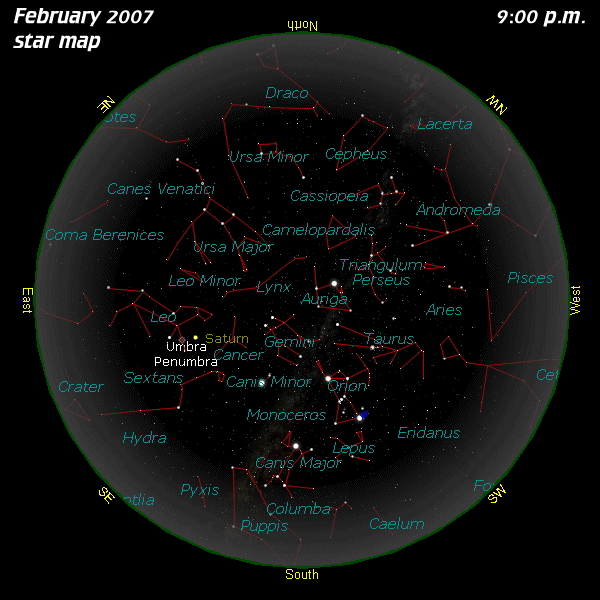



![[Moon Phases]](../moonphases/2007-02-phases.jpg) |
|---|
| Solar X-rays: Geomagnetic Field: |
 |
Current Moon Phase | †
![[Venus and Mercury]](2-07-03-mercury-venus.jpg) |
|---|
| This image of Venus and Mercury (fainter and nearer to the trees) taken on February 3rd was aided by thin clouds which diffused their light making them appear brighter. Mercury was easily visible to the unaided eye in this photograph taken by Gary A. Becker from Coopersburg, PA. |
![[Meteor Crater Pit]](2-07-meteor-crater-wide.jpg) |
|---|
| Meteor Crater near Winslow, Arizona is 4,100 feet in diameter and 550 feet deep. Its crater walls rise as high as 200 feet above the surrounding landscape. This composite image was created by stitching together three separate photos. Images by Gary A. Becker... |
![[Meteor Crater Wall]](2-07-meteor-crater-walls.jpg) |
|---|
| Meteor Crater's walls are higher than the surrounding terrain, one of the many characteristics of impact craters. Image by Gary A. Becker... |
![[Looking into Meteor Crater]](2-07-meteor-crater-velivis.jpg) |
|---|
| Brandon Velivis of Albuquerque, NM stands above one of the bore holes drilled into the flank of the crater in search of the parent meteorite. The original drilling area is visible as a white spot in the center of the crater. The visitor center can be seen as the dark silhouette along the craterís rim, just to the right of center. Image by Gary A. Becker... |
![[Mercury and Venus]](2-07-04-mercury-venus.jpg) |
|---|
| On the incredibly clear but cold evening of February 4th, I had never seen Mercury (above trees, center) shine so brightly. It was distinctly visible by 6:00 p.m. Above and to the left of Mercury is Venus. See the photo of Mercury and Venus taken the previous evening at the top of this page. Gary A. Becker photo... |
![[Mercury and Venus]](2-07-05-mercury-venus.jpg) |
|---|
| The temperature was 11 degrees F. when this picture of Mercury (above trees, center) and Venus was taken from Coopersburg, PA on February 5th. I believe that the air was even more transparent than the night before. Mercury was photographed under brighter sky conditions. Note the clarity of the other stars in the picture. Gary A. Becker photo... |
![[Mercury, Venus, and Uranus]](2-07-07-mercury-venus.jpg) |
|---|
| Mercury, Venus, and Uranus grace this picture taken from Coopersburg, PA on another unusually clear evening. Stars fainter than 7th magnitude were recorded during this 10-second digital exposure taken with a tripod mounted Canon D20 camera on February 7th. Gary A. Becker photo... |
![[Mercury, Venus, and Uranus]](2-07-08-mercury-venus.jpg) |
|---|
| Notice how Venus and Mercury have moved with respect to the star field and the horizon in just one day. Mercury will continue to move towards the right and get lower each day, while Venus will move towards the upper left against the starry background. Gary A. Becker photo taken on February 8th... |
![[Mercury, Venus, and Uranus]](2-07-09-mercury-venus.jpg) |
|---|
| Mercury and Venus (brighter) are visible from Coopersburg, PA despite high clouds which plagued the west on the evening of February 9th. Gary A. Becker digital photo... |
![[Orion's Sword]](2-07-orions-sword.gif) |
|---|
| Orion's Sword, composed of NGC 1977 (The Runnin Man), M43, M42 (Orion Nebula) and NGC 1980 shines brightly in this stunning photograph recorded by Gerhard Bachmayer of Kaltenleutgeben, Austria. Graphics by Gary A. Becker... |
![[Mercury and Venus]](2-07-10-mercury-venus.jpg) |
|---|
| Mercury (near to the trees) is starting to make its turn downwards, a motion which will rapidly bring it to a position between the Earth and the sun, inferior conjunction. This 13 second digital image was taken from Coopersburg, PA on the evening of February 10th by Gary A. Becker. |
![[Mercury and Venus]](2-07-11-mercury-venus.jpg) |
|---|
| Mercury just above the trees may be bidding adieu to the Lehigh Valley with the impending cloudiness and bad weather predicted over the next several days. This 13 second digital exposure was taken from Coopersburg, PA on the evening of February 11th by Gary A. Becker. |
![[March 3 Total Lunar Eclipse]](3-07-total-lunar-eclipse.gif) |
|---|
| Make plans to view the total lunar eclipse of March 3. Members of the Allentown School District Planetarium's StarWatch Team of student and volunteer observers will have their telescopes set up for the public at the Quakertown (PA) Airport. Plan to arrive by sunset as the eclipsed moon becomes visible in the darkening sky. A Go/No Go message will be posted by 3 p.m. on the front page of www.astronomy.org if weather conditions look unfavorable. Diagram by Gary A. Becker... |
![[30-hour Moon, February 18]](2-18-07-30hr-moon.jpg) |
|---|
| This image of the moon 30 hours after its new phase was photographed on February 18 after the passage of a dry cold front. The final line of clouds had passed the moon about 20 minutes before this image was taken. The lonely star to the left of the moon is Phi Aquarii, a red giant nearing the end of its life. Photography by Gary A. Becker... |
![[Moon and Venus, February 19]](2-07-19-venus-moon.jpg) |
|---|
| This digital photograph of the moon and Venus was taken on the following evening, February 19. Hazy conditions gave this image an eerie look. Photography by Gary A. Becker... |
![[Quakertown (PA) Airport]](2-07-quakertown-airport.jpg) |
|---|
| Quakertown Airport will be the observing site for the March 3rd total lunar eclipse. This picture looks eastward into Quakertown, PA with the small industrial park mentioned in the article to the left of the image. Photography by Gary A. Becker... |
![[Google Map of Quakertown (PA) Airport]](2-07-quakertown-airport-map.jpg) |
|---|
| Use this bird's eye view of the Quakertown Airport in addition to the article above to help find the observing location for the March 3, 2007 total lunar eclipse. Google Maps... |
 |
